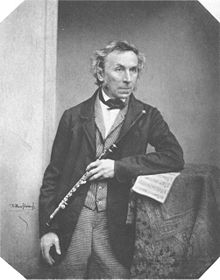
Theobald Boehm
Encyclopedia

Germany
Germany , officially the Federal Republic of Germany , is a federal parliamentary republic in Europe. The country consists of 16 states while the capital and largest city is Berlin. Germany covers an area of 357,021 km2 and has a largely temperate seasonal climate...
inventor and musician
Musician
A musician is an artist who plays a musical instrument. It may or may not be the person's profession. Musicians can be classified by their roles in performing music and writing music.Also....* A person who makes music a profession....
, who perfected the modern Western concert flute
Western concert flute
The Western concert flute is a transverse woodwind instrument made of metal or wood. It is the most common variant of the flute. A musician who plays the flute is called a flautist, flutist, or flute player....
and its improved fingering system
Boehm System
The Boehm system is a system of keywork for the flute, created by inventor and flautist Theobald Boehm between 1831 and 1847.Prior to the development of the Boehm system, flutes were most commonly made of wood, with an inverse conical bore, eight keys, and tone holes that were small in size, and...
(now known as the "Boehm system"). He was a Bavarian court musician, a virtuoso flautist
Flautist
A flautist or flutist is a musician who plays an instrument in the flute family. See List of flautists.The choice of "flautist" versus "flutist" is the source of dispute among players of the instrument...
, and a celebrated composer
Composer
A composer is a person who creates music, either by musical notation or oral tradition, for interpretation and performance, or through direct manipulation of sonic material through electronic media...
for the flute.
Biography
Born in MunichMunich
Munich The city's motto is "" . Before 2006, it was "Weltstadt mit Herz" . Its native name, , is derived from the Old High German Munichen, meaning "by the monks' place". The city's name derives from the monks of the Benedictine order who founded the city; hence the monk depicted on the city's coat...
in Bavaria
Bavaria
Bavaria, formally the Free State of Bavaria is a state of Germany, located in the southeast of Germany. With an area of , it is the largest state by area, forming almost 20% of the total land area of Germany...
, Boehm learned his father's trade of goldsmith
Goldsmith
A goldsmith is a metalworker who specializes in working with gold and other precious metals. Since ancient times the techniques of a goldsmith have evolved very little in order to produce items of jewelry of quality standards. In modern times actual goldsmiths are rare...
ing. After making his own flute, he quickly became proficient enough to play in an orchestra at the age of eighteen and at twenty-one he was first flautist in the Royal Bavarian Orchestra. Meanwhile, he experimented with constructing flutes out of many different materials—tropical hardwoods (usually Grenadilla wood), silver, gold, nickel and copper—and with changing the positions of the flute's tone holes. After studying acoustics
Acoustics
Acoustics is the interdisciplinary science that deals with the study of all mechanical waves in gases, liquids, and solids including vibration, sound, ultrasound and infrasound. A scientist who works in the field of acoustics is an acoustician while someone working in the field of acoustics...
at the University of Munich
Ludwig Maximilians University of Munich
The Ludwig Maximilian University of Munich , commonly known as the University of Munich or LMU, is a university in Munich, Germany...
, he began experimenting on improving the flute in 1832, first patent
Patent
A patent is a form of intellectual property. It consists of a set of exclusive rights granted by a sovereign state to an inventor or their assignee for a limited period of time in exchange for the public disclosure of an invention....
ing his new fingering system in 1847. He published Über den Flötenbau ("On the construction of flutes"), also in 1847. His new flute was first displayed in 1851 at the London Exhibition. In 1871 Boehm published Die Flöte und das Flötenspiel ("The Flute and Flute-Playing"), a treatise on the acoustical, technical and artistic characteristics of the Boehm system flute. Some of the flutes he made still function. His fingering system has also been adapted to other instruments, such as the oboe
Oboe
The oboe is a double reed musical instrument of the woodwind family. In English, prior to 1770, the instrument was called "hautbois" , "hoboy", or "French hoboy". The spelling "oboe" was adopted into English ca...
and the clarinet
Clarinet
The clarinet is a musical instrument of woodwind type. The name derives from adding the suffix -et to the Italian word clarino , as the first clarinets had a strident tone similar to that of a trumpet. The instrument has an approximately cylindrical bore, and uses a single reed...
.
External links
- Alto flute, Boehm and Mendler, Munich, ca. 1880 at The Metropolitan Museum of Art
- On the construction of flutes

